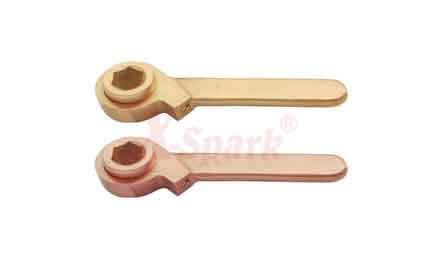Non-sparking or safety tools are very different from the traditional hand tools commonly used in machine shop professionals' tool kits. In fact, traditional hand tools, such as wrenches, are usually made of high-strength alloys of chrome vanadium steel. This material is not suitable for use in equipment in potentially explosive environments: in fact, if a steel wrench will fall in such an environment, it may produce sparks, cause explosions or fires, thereby endangering the lives of all workers on the platform.
Non-sparking tools, also commonly referred to as "spark reduction", "spark resistance" or "flame retardants", are used in working environments that contain flammable gases, vapors, dust, residues, and liquids. They prevent sparks, thereby eliminating the risk of fire and explosion.
Important advice: Thoroughly clean all non-sparking tools after use, and make sure that they are free of any iron contaminants or rust, which will damage the non-sparking performance of the tools.
In addition, it is important not to use tools in direct contact with acetylene in the presence of major moisture, as this may lead to the formation of highly dangerous explosive acetals.
In addition, don’t forget to sharpen all explosion-proof tools regularly and follow safety procedures such as protecting your face and eyes, and using appropriate tools to collect the powder.
Finally, it is very important to ventilate the site to remove potentially harmful powders and vapors from the atmosphere.
You can follow some simple rules to ensure the durability of the tools and minimize the potential hazards in the workplace.
Non-sparking insulated tools have unique characteristics that make them suitable for environments containing flammable materials. By helping them to complete their work safely, they make the work of professionals working in industries such as oil refineries and coal mines easier.
Tools that are properly cleaned and protected from contamination will have a longer service life, which will also reduce their ability to not generate sparks. When the industrial working environment requires safety, it is best to use non-sparking tools.
Workers widely use non-sparking tools in places prone to explosions hazards. Explosions usually occur due to flying sparks, and traditional steel hand tools are the main cause of this danger. The use of steel hand tools usually causes friction. Sparks from friction can cause a greater proportion of fires and explosions. Therefore, the demand for non-sparking tools has become more and more important, leading to the widespread use of hand tools made of non-ferrous materials.
The fact that hand tools made of non-ferrous materials can significantly reduce the risk of fire caused by sparks has led to an unprecedented demand for these non-sparking tools. Non-sparking tools are made of non-ferrous materials, such as alloys of copper, brass, bronze, nickel, beryllium, and aluminum. Compared with hand tools with iron, hand tools with iron parts are relatively soft.
We are Non-sparking tools Suppliers. If you are interested in our products, please feel free to contact us.

评论
发表评论